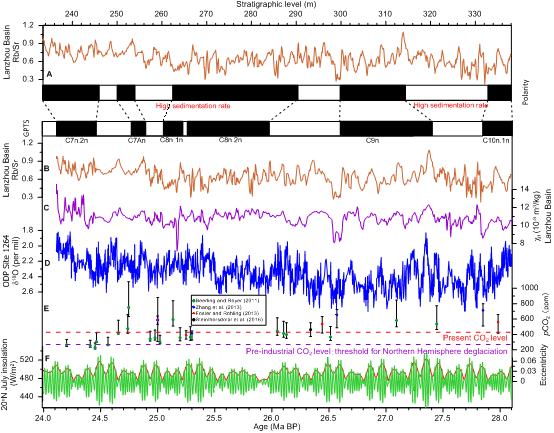Orbital-scale Asian Monsoon Variability and Dynamics in the Late Oligocene High CO2 World
A recent study by an international research group led by Prof. AO Hong from the Institute of Earth Environment of the Chinese Academy of Sciences has revealed orbital-scale Asian monsoon variability and dynamics under high atmospheric CO2 and warm climate conditions of the late Oligocene.
The joint research team comprised scientists from China, UK, Netherlands, and Australia. The group’s findings were published in Science Advances on 15th Dec.
Earth transitioned from a warm greenhouse state without permanent ice sheets on both poles to a cooler, but still substantially warmer than today, unipolar icehouse state with the sole continental-scale ice sheet on Antarctica across the Eocene–Oligocene transition at ~34 million years ago (Ma). The Oligocene between 33.90 and 23.03 Ma represents the first epoch in the newly established unipolar icehouse world, with atmospheric CO2 concentrations were between ~400 and ~800 parts per million (ppm) that embrace the present-day and projected values for the year 2100, average global sea surface temperature >8°C higher today, and an ice-free Northern Hemisphere.
“Knowledge of monsoon variability and dynamics in the Oligocene high CO2 world has important implications for the rapid out-of-equilibrium present-day monsoon responses to an anthropogenic CO2 increase and helps to improve the prediction of future hydrological changes following the sustained atmospheric CO2 and temperature increases as projected by Intergovernmental Panel on Climate Change (IPCC) Sixth Assessment Report” said Prof. AO, the principal investigator of the study.
The researchers established 4-Myr-long summer monsoon records (magnetic susceptibility and rubidium-to-strontium ratio) continuously spanning the period from ~28.1 to ~24.1 Ma at ~4-thousand-year (kyr) resolution from a well-developed distal alluvial sedimentary sequence in the Lanzhou Basin (China) on the northeastern Tibetan Plateau margin. They find that the regional Asian summer monsoon precipitation was characterized by prominent ~400-kyr and ~100-kyr periodicities between ~28.1 to ~24.1 Ma, consistent with a dynamic response to a combination of eccentricity modulation of solar insolation, a low-latitude forcing, and glacial-interglacial Antarctic ice sheet fluctuations, a high-latitude forcing. This finding imply that Asian monsoon may become increasingly susceptible to sustained global warming as anthropogenic emissions continue to increase.
This study was supported by the Chinese Academy of Sciences, the Ministry of Science and Technology of China, and the National Natural Science Foundation of China.

Global climate and Lanzhou Basin precipitation changes on orbital time scales during the late Oligocene. (Image by AO Hong)
Contact: Bai Jie, Institute of Earth Environment, Chinese Academy of Sciences, Xi'an, China. Email: baijie@ieecas.cn
 © 2015 Institute of Earth Environment,CAS
© 2015 Institute of Earth Environment,CAS Address:No. 97 Yanxiang Road, Xi'an 710061, Shaanxi, China

 Location :
Location :